J. Kirk Richards
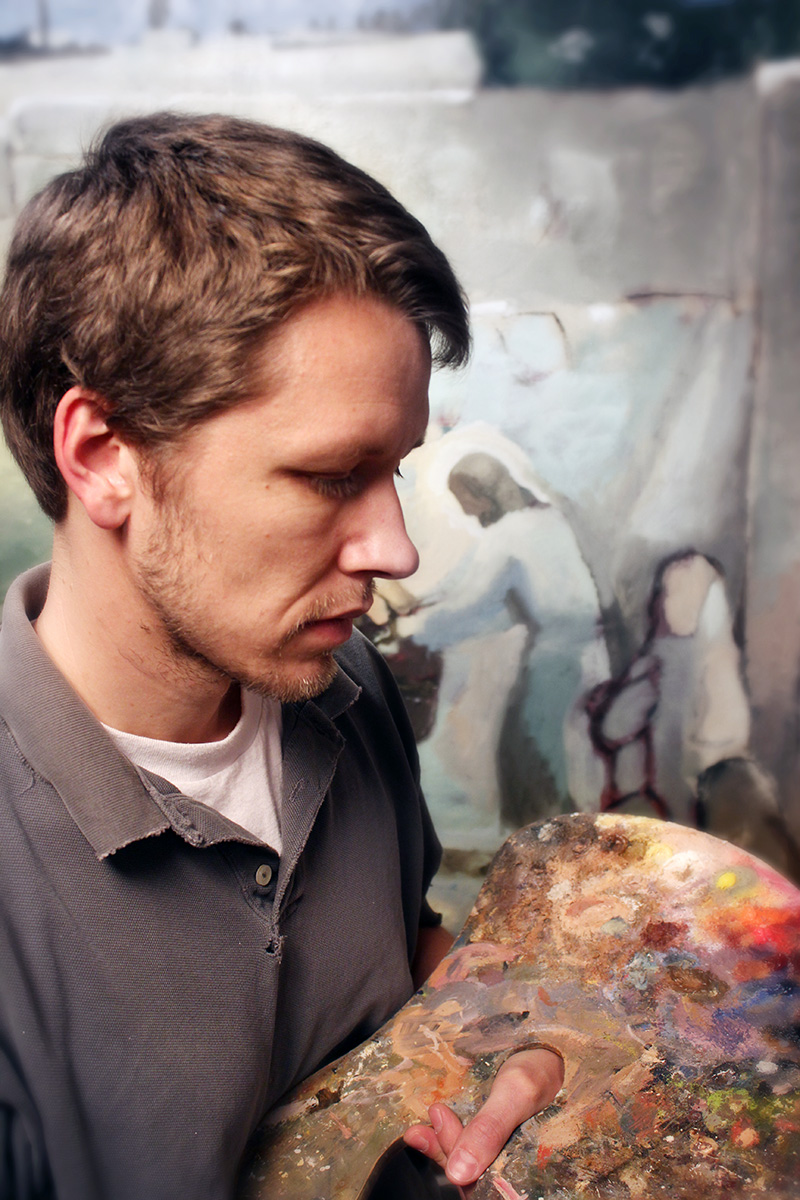
What have you been working on in the past five years? What are you working on right now?
The past five years have been exciting for me. One of my dreams had been to paint the story of the birth of Christ and to publish it in book form. I went ahead and painted paintings for the project, and Deseret Book picked it up. They published The Nativity last Christmas. As a second project with Deseret Book, I abridged and illustrated A Christmas Carol by Charles Dickens, which will hit stores this October. And now I’m working on The Easter Story for next spring, which tells of the Passion and Resurrection of Christ with scripture and artwork.
In terms of gallery and museum work, earlier this year, and with help from friends, I painted 150 depictions of the face of Christ. The paintings all hang together as a single work of art at UMOCA in Salt Lake City. That show runs through December of this year. I’m also wrapping up a fourteen-foot-wide painting of Christ healing the sick and afflicted. It will be displayed at Illume Gallery at City Creek beginning the second week of September.
You have a new studio space where you hold workshops and teach. Who are your students? What are your goals of workshops and teaching?
In actuality, I do have a studio space used primarily for my own work. Most of my extra large or extra messy projects are done there. I teach infrequent workshops, often geared toward young artists at the beginning of their careers. My goals are to help them develop a unique voice with greater confidence and to give them some ideas about how to navigate the business of being a professional artist. I generally emphasize strong compositional design; eye movement and rhythm; simplification and idealization of form; and pushing one’s boundaries by painting from life, from imagination, and from photographic reference.
What would a student’s experience in your studio look like?
It really depends on the student’s goals. I want to help each student grow into their own style and voice. That’s particularly challenging for a young artist who wants to hear absolute answers about how art should be made. My approach is to channel each person’s strengths and take them to the next level. So it looks a little different for each person.
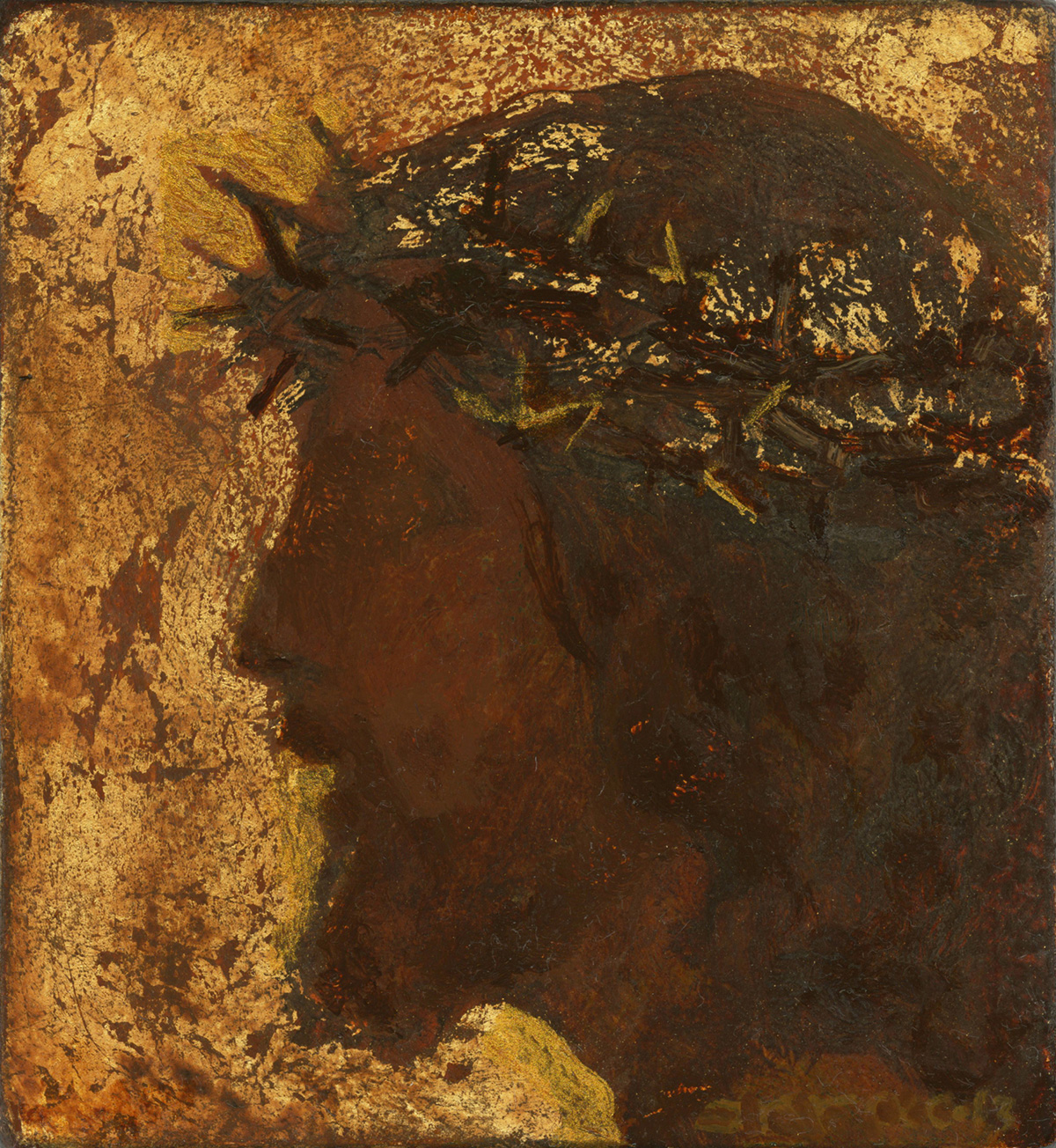
You visited Jerusalem last year. What are some key experiences you had while there?
I’ll quickly mention three:
The first one occurred on Palm Sunday. My daughter and I hurried on foot through the streets of the Mount of Olives toward Bethpage, to meet the Palm Sunday procession to Jerusalem. For a moment, my mind was transported back in time. I felt like just around the next corner we would actually see Jesus riding on a donkey and follow him with triumphant praises into old Jerusalem.
The second was in the Garden of Gethsemane, which is enclosed within the walls connected to the Church of All Nations. The garden contains ancient olive trees, not quite old enough to have existed during the time of Christ’s Atonement; but perhaps when they were young trees, they stood next to other ancient trees that witnessed Christ’s great sacrifice. I brought my paints into the garden and painted a small painting of one of these beautiful, gnarled olive trees. Emotions welled up within me as I experienced that sacred place.
The third was at the Western Wall of the Temple Mount. I placed a cap on my head and said a prayer at the wall. The prayer somehow felt transitional for me—as if it marked the end of one era of my life and the beginning of another era. Some might say that a prayer is closer to God’s ears when given at the Western Wall. I certainly felt that way. Again, I think the sacredness of the place added to the experience.
How has that visit influenced your work?
I’m just now close to finishing some of the paintings that were begun after the Jerusalem trip. Hopefully the textures of the stone, the colors of the skin, the glimpses of the ancient architecture, the atmosphere of the Holy Land will come through in some of these new paintings. I don’t pretend my new paintings will be historically accurate. Some people may get dogmatic about what they assume to be accurate. But hopefully, in my paintings, there will be an accuracy of feeling that transports the viewer to the spiritual reality of Jerusalem.
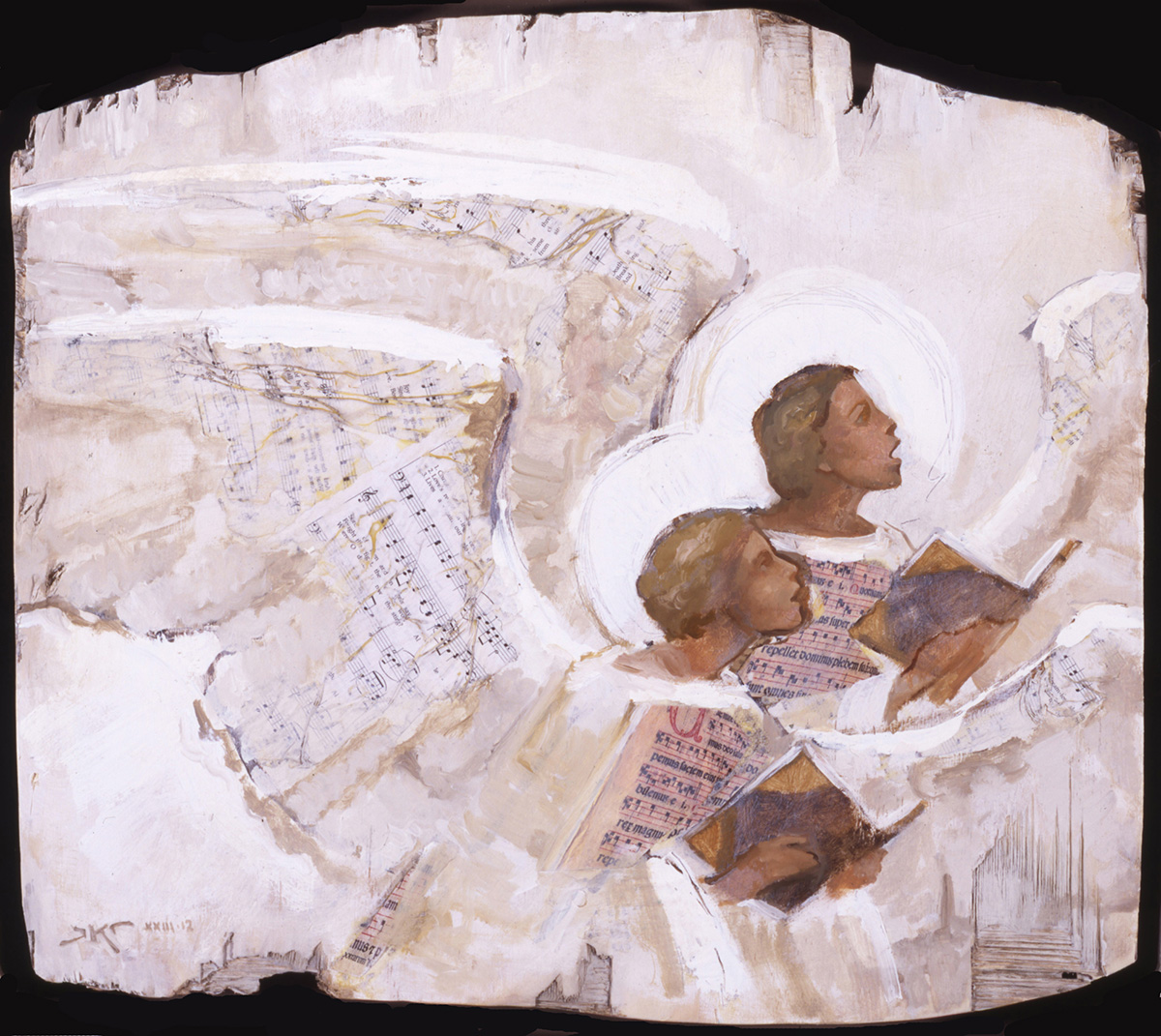
You’ve mentioned in a previous Mormon Artist interview that one of the things you love is “a narrative as it relates to the painting.” How does that manifest in your work? What are some narratives you’ve been working with recently? How do you find narratives to work with?
In any community, and certainly in our LDS community, common narratives come into play when analyzing a picture. For example, we see a picture of a bearded man suffering in a grove of olive trees. We automatically think of the Atonement and our memory recalls the scriptural account of Christ’s suffering from the gospels, as well as modern scriptures, reminding us that Jesus “descended below them all.” Most of our religious culture is built upon a rich collection of narratives. In my artwork, I like to refer to those narratives in new ways, perhaps delving into scriptures that have rarely been depicted, or perhaps attempting to paint common scriptural scenes in new ways. I seem to come back again and again to narratives of healing, of working in the Lord’s vineyard, of praising him through music and song, and of manifestations of angels or heavenly messengers.
In your keynote address at the 2013 Association for Mormon Letters (AML) Annual Symposium, you discussed a triangle with three corners: classical, realist, and abstract. These represented different stylistic approaches artists can take when painting sacred subjects. You said your quest is to find a “sweet spot” between those. Tell us about that process.
It’s perhaps an oversimplification of a more complex reality, but, in my mind, each of those three stylistic approaches has its own inherent strengths and weaknesses. My goal is to tap into the strengths of all three—to capture the perfection, the elegance, and the exaltedness of the classical ideal; as well as the physicality, the relatability, and the earthiness of realism; and finally the broad idea, the principle, the parable of the abstract. My hope is to find a magical combination of these seemingly disparate elements—a combination that is engaging and moving at least to me and hopefully to others as well.
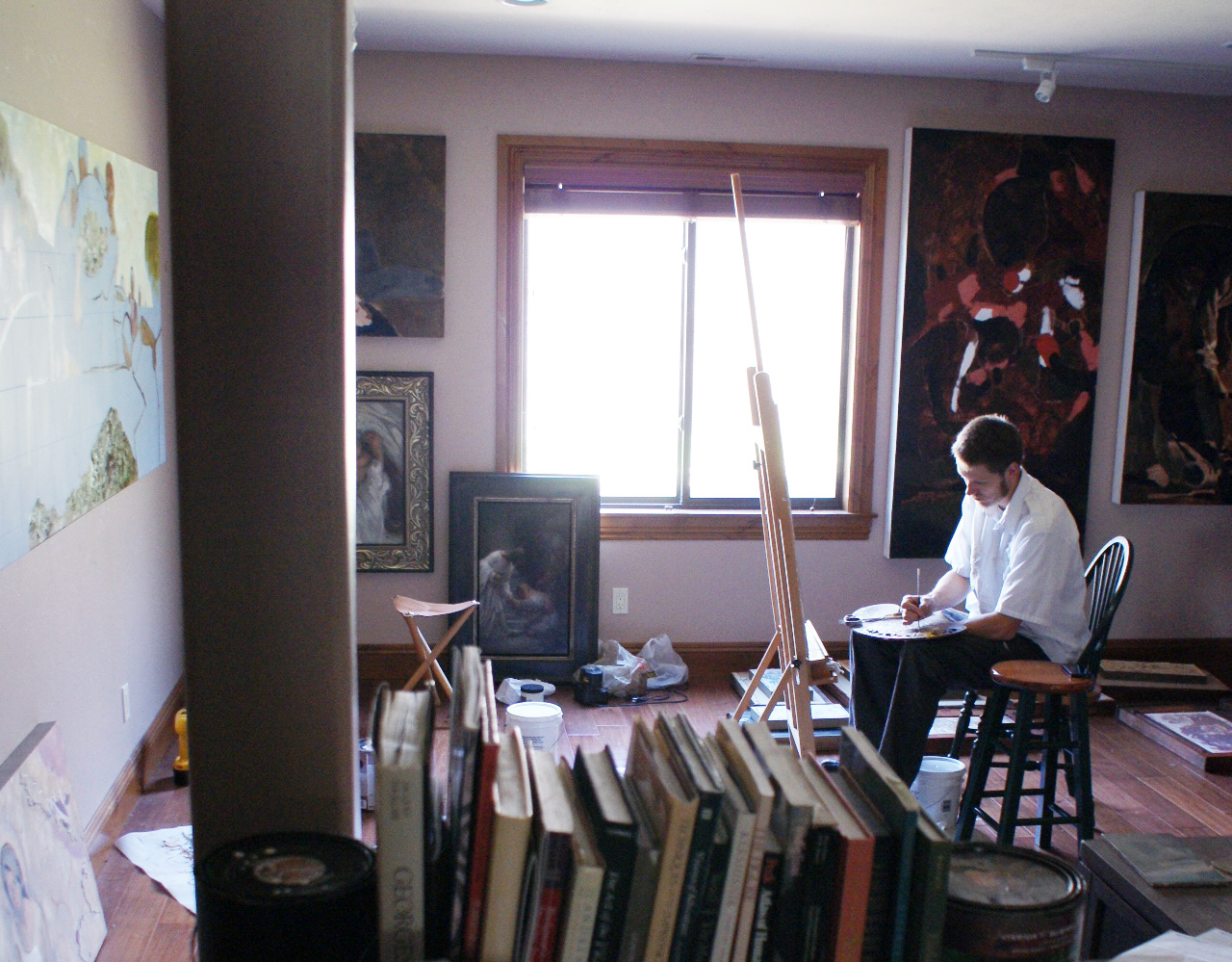
When painting Christ, you’ve done work that has at times been classical, realistic, and abstract. You mentioned that when painting the Savior, you feel that your abstract pieces have come closest to “getting it right.” Why do you think this is?
Of course this is extremely subjective territory, since we well know that beauty is in the eye of the beholder. My feeling, though, is that it’s easy to get it “wrong” when infusing a portrayal with lots of distracting details—details that most of us don’t have personal experience with since most of us have not personally seen the face of Christ. But we all have personal experience with the unseen Spirit of Christ. Abstract images are first and foremost symbols. We recognize them as symbols. We look at an abstract depiction of Christ and our brain tells us, “That represents Christ.” In contrast, we look at a realist painting of Christ and our brain tells us, “This is what the artist thinks Christ looks like—I wonder who the artist used for a model.”
How do you know you’re closer to “getting it right”?
I only know what I feel. I’ve experimented with many different looks and stylistic depictions of the Savior. I’ve failed many times. In order for me to be happy with a painting of Christ, it must achieve some sort of aesthetic perfection—even if it’s a modern or primitive perfection. And it must evoke those feelings we feel toward our Savior: that he is merciful, loving, powerful, knowing, just, righteous—indeed perfect.
You’ve been working on a book: Forty Images of Christ. Why paint forty images of Jesus?
The book is simply a compilation of some favorite paintings I’ve done of the Savior. Forty is one of those numbers that appears from time to time in the scriptures: the rains flooded the earth for forty days, Moses went up to the mountain for forty days, Jesus fasted for forty days and forty nights.
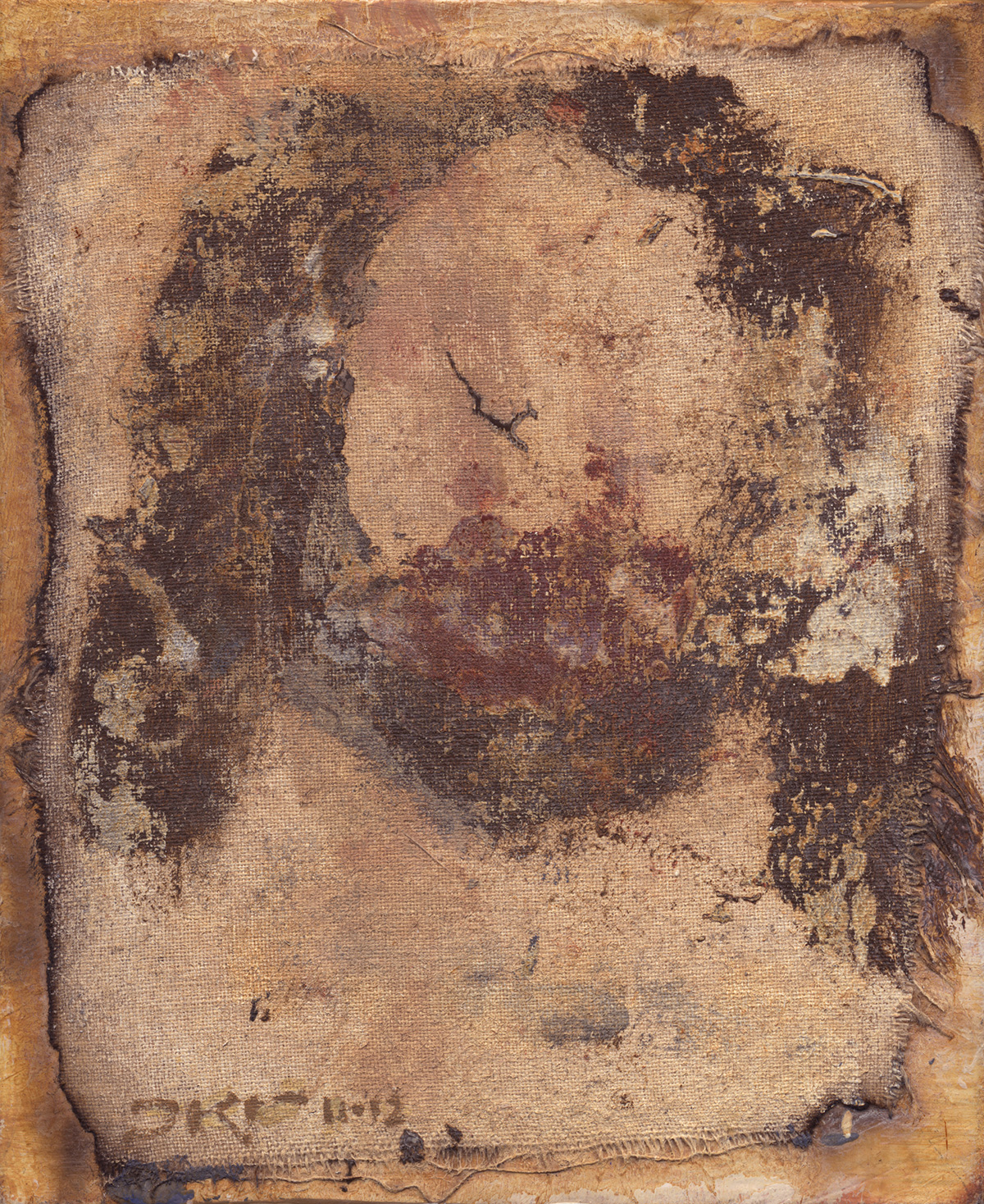
The book has come out of a much larger volume of paintings you’ve done of Christ. What keeps this theme fresh for you?
There’s a parable where Jesus talks about two men who went into the temple to pray. The second man “would not lift up so much as his eyes unto heaven, but smote upon his breast, saying, God be merciful to me a sinner” (Luke 18:13). I can relate a lot to this second man. My paintings of Christ are in some ways a prayer for mercy, or an attempt to overcome what oftentimes seems like a host of insurmountable obstacles. The need for seeking Christ and forgiveness never dissipates, and so the theme is always fresh.
How does an artist experiment with his or her painting style and also manage to keep selling work? Are there any practical concerns about maintaining a brand?
I’ve always felt that experimentation is an essential ingredient to the health of an artist and his or her work. That said, I would rarely recommend making a clean break or completely abandoning what has produced results for an artist in the past. Most artists’ work probably evolves gradually. They push the boundaries by introducing a few new elements at a time—trying a similar composition with a different color scheme. Or using the same colors but trying a different theme. Or changing the scale of the work. Or doing a few pieces each year that are significantly different from past work and seeing where that leads in the future. The more work you do, the easier it is to experiment.
You mentioned in your earlier Mormon Artist interview that if you did more secular work, rather than religious-themed work, there were some major galleries who would take your paintings. Some have explicitly told you this. Have you ever found the prospect of not working with these galleries difficult? What keeps you committed to doing art that tends to be religious-themed?
Since that interview, many galleries have gone by the wayside. Others have changed their tone and softened toward spiritually themed work. I’m very happy about this path I’m on. I paint the themes I love most. I imagine there will always be biases against what I’m doing.
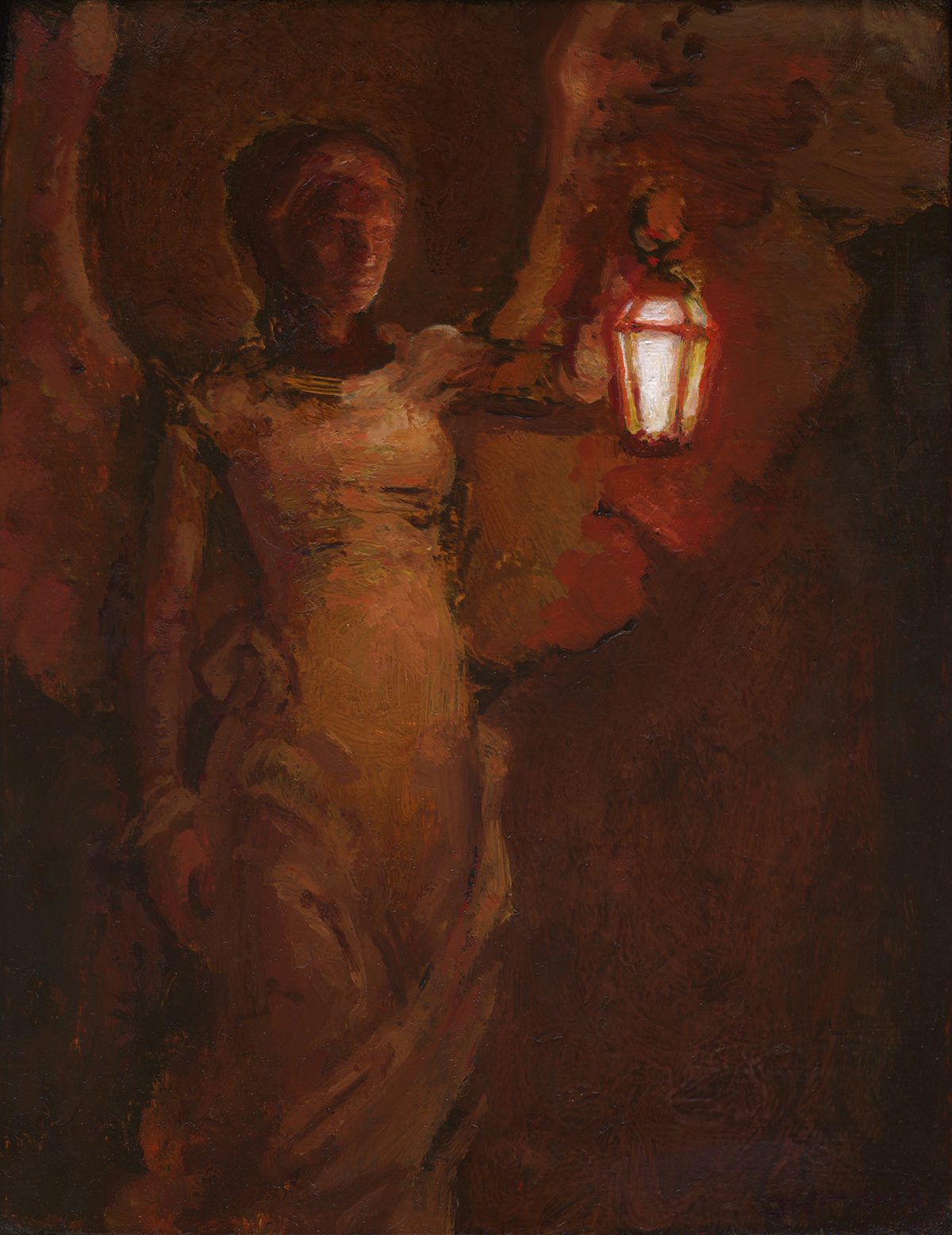
What would you tell other artists who would like to do spiritually themed work but have similar concerns about galleries not taking their art?
I would say this: Your name is so integrally important to what you do as an artist. One option is to build a name for yourself making secular work, and achieve such excellence that you can then turn toward religious themes having already established a big name elsewhere. A second option is to have two names—an artist’s name, much like a pen name or stage name, for a second type of work. Two parallel careers might then develop simultaneously. A third option is to have faith that the world will change, paint what you will, and let the chips fall where they may. I do believe that you can change the world with your art.
At the AML symposium, you showed some pieces from your personal collection of artwork depicting Jesus that you’ve collected from other artists. Many of them are artists you personally know, many of them LDS. Some of the artists used media they don’t ordinarily use; others don’t produce much work as artists but made a special exception for you. Among these works were a drawing by your son and a woodblock print by a 14-year-old boy who has turned to his relationship with Christ after suffering from health problems. What is the significance of this collection to you?
I feel a special connection to images of Christ, partly because my life’s pursuit has been creating similar images, but also because we all have a personal connection with Christ. And each of our connections with Christ is a unique connection. He knows our hearts. He knows our unique struggles and personalities. There is a similar uniqueness in artwork. I love seeing and collecting a variety of Christ images because it reminds me of the many ways we relate to him.
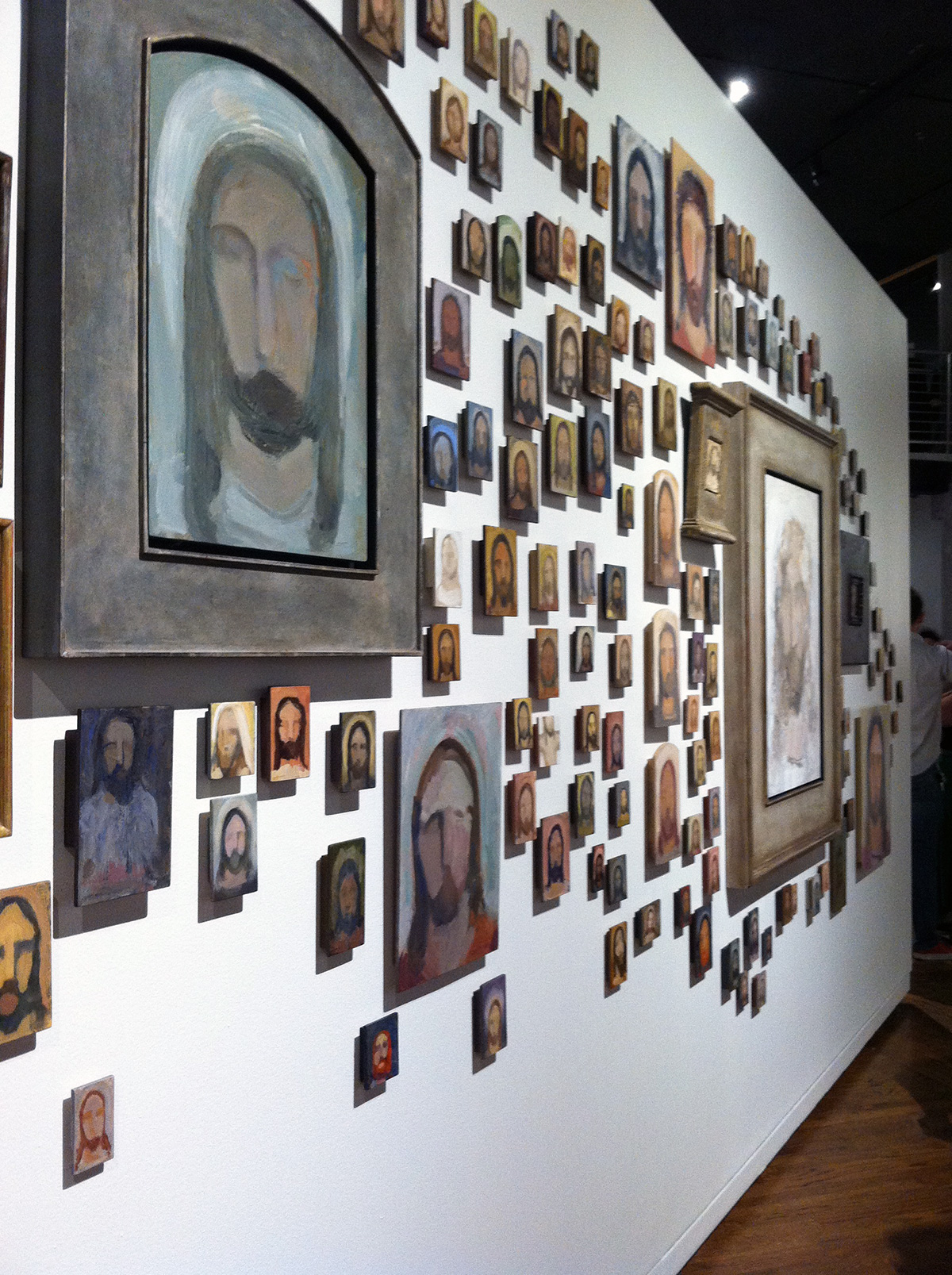
In your AML keynote, you said that your reaction when someone is skeptical about the quality of LDS art is “You can complain or you can contribute.” How have you tried to contribute?
I have made the attempt. I have made pictures. I’ve thrown my hat into the ring of sacred imagery. I’ve participated in venues, sometimes when I haven’t wanted to, partly because I felt it was important to let my voice be heard—to let my aesthetic be seen. Also, I’ve tried to improve. We can contribute by learning about excellence. We can contribute by pushing our limits higher.
What are your suggestions for other LDS artists who would like to contribute?
Work hard. Be bold with your voice. Continually improve your craft. There is excellence and beauty throughout the history of the world, and we have unprecedented access to it. Let that excellence combine with the gospel to inspire and inform your work. Know that it will be an uphill climb to carve your own niche. Be patient and persistent.
At the AML symposium, you talked about a lecture at the Jerusalem Studio School given by Israel Hershberg. You said, referring to different styles of painting, “The art is not revealing something when it’s all revealed. When we’re talking about Church magazines, the principal goal is to show what has been revealed, what we know. But is that what art is about? I think that’s a small fraction of what some part of art is about. But the larger perspective is about revelation—we want the viewer to have a revelatory experience of their own while they are viewing it. And that is hard for anybody with any sort of artistic soul when it is all laid out in detail from the outset.” Can you elaborate on art and revelation?
Art has many uses. Think, though, to a time when you were particularly moved by a piece of art. Was there not some sort of revelation involved? Did you not suddenly see something you couldn’t see before? Did you not realize something about yourself or about the world that you’d never realized before? Art, in all of its forms, has a special ability to make this happen in us. I think that’s art at its best.
Is “revelation” Mormon terminology for “interpretation” or is there a difference?
I think they are different. Interpretation is based on the viewer’s previous life experience, on knowledge of the artist and of the artist’s historical context. An interpretation might be “Carl Bloch is trying to get across the importance of service in his painting of the Pool of Bethesda. He’s beautifully rendering a moving scene from the Gospel of John. The man looking straight at us asks us to participate in the scene.” In contrast, a revelation from the same painting might be “Oh, my goodness. I’ve been so focused on that man underneath the blanket, I didn’t notice the man crawling on his hands behind Christ. I’ve been giving so much of my attention to my one brother that needed help, I didn’t even think to notice that my other brother is in desperate need as well.” Revelation involves an epiphany—the Spirit of the Lord speaking to our heart and mind.
That’s one thought. Another thought is that revelation is the sudden, sometimes visceral—but certainly spiritual—discovery of what a work contains, even before the viewer has time enough to form an interpretation.
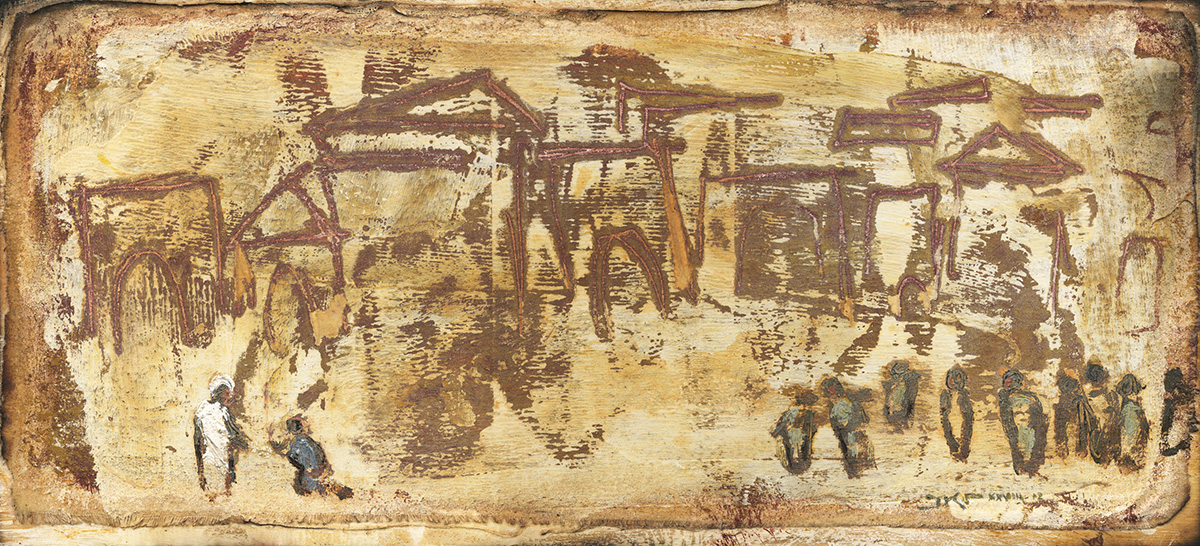
In your earlier interview, you said, “The gospel has definitely provided subject matter, a point of reference, and a community that allows me to do what I like to do.” What are some specific examples of the gospel providing subject matter and a point of reference?
The doctrines of the restored gospel give a unique view of God’s eternal plan. Eternal families, for example. How many great works of art have yet to be created relating to the theme of eternal families? As God is, man may become. What a great theme to explore in painting, song, and literature! The future is bright for the Mormon artist. I have tried my hand a few times at some of these themes. I recently created a large painting of the breath of life being breathed into Adam by a Heavenly Father and a Heavenly Mother.
What do you find are helpful elements in building a community of artists, particularly Mormon artists?
I confess at times I opt for seclusion rather than community, but allow me to mention a few things that have been helpful to me: (1) Group exhibitions geared toward living, working artists like those sponsored by the Church Museum of History and Art and the Springville Museum of Art, (2) rendezvous where artists from various disciplines can meet each other and foster future collaborations, such as those sponsored by the Mormon Arts Foundation, (3) publications like Mormon Artist that help us to get to know each other, (4) social networking, (5) academic meetings surrounding the arts, such as those sponsored by the Mormon Scholars in the Humanities and the Association for Mormon Letters.
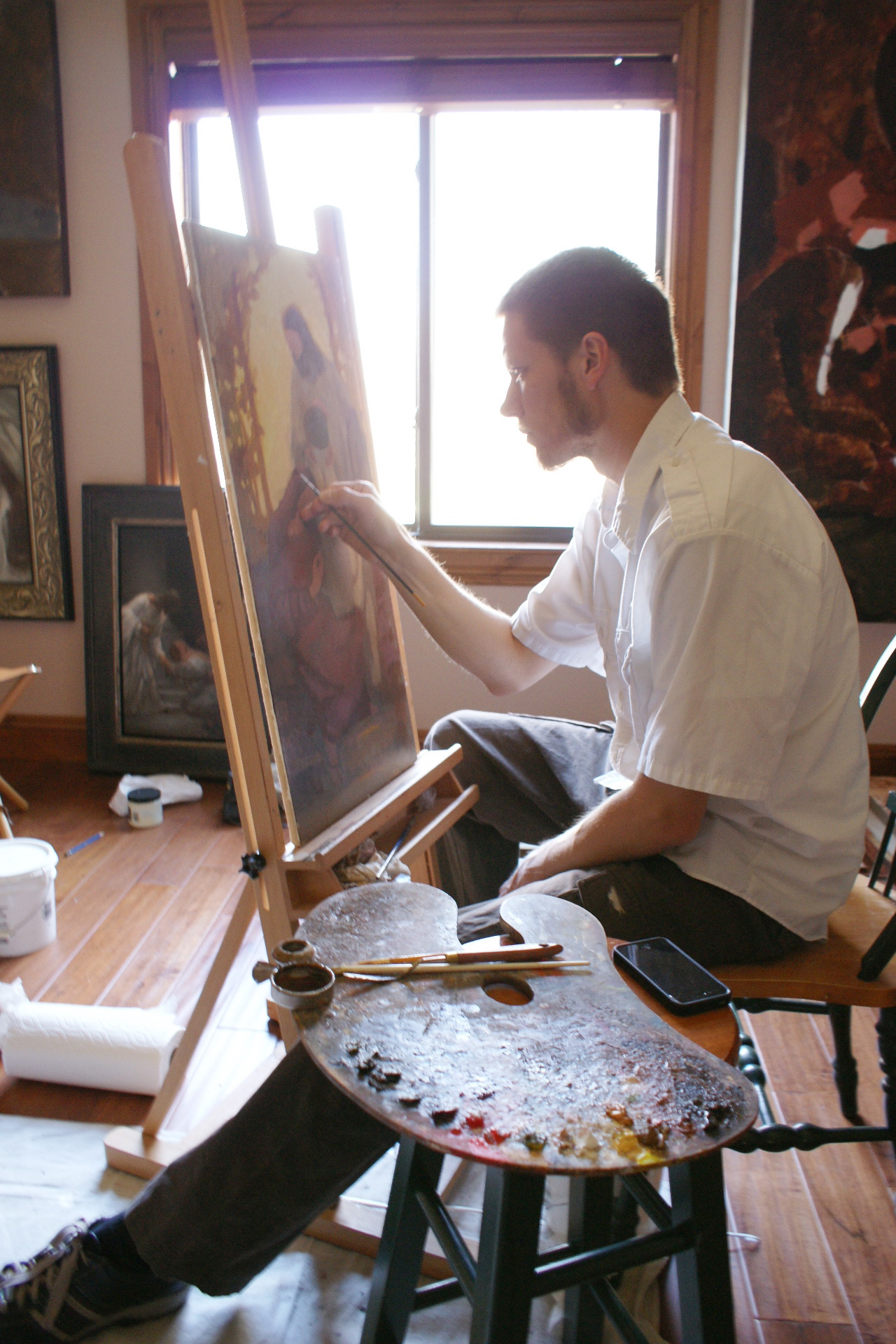
What would you like to see happen in this community?
I’d love to see our professional visual artists come together to create a network of educational opportunities, so that young artists can navigate more fluidly through a variety of mentors. I’d love to see the Wasatch Front become an art destination for the world, with private, specialized art museums and galleries. I’d love to see our curators move on to world venues like the Met and the MoMA, and to have them bridge the gap between regional Mormon art and art that receives world-class recognition, by curating new shows that encourage our artists to speak with a bold, contemporary voice. I’d love to see new art patrons within our community investing in significant, large-scale works of art. Right now, the main sources of funding for large works are the government and the Church. An increasingly secular government cannot sponsor religious works. And a church concerned with appropriateness and distraction will only sponsor the safest, most dogmatic, and most calm of artworks. It falls on private patrons, then, to fund the creation of dramatic spiritual works—works that truly explore the heights and depths of the great plan of salvation.
What do you feel this community has to offer artistically?
The sky is the limit. Our culture is young. The future promises a diverse artistic offering, full of faith and divine craftsmanship. As we push ourselves, God will open doors for us. ❧
